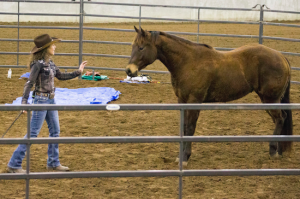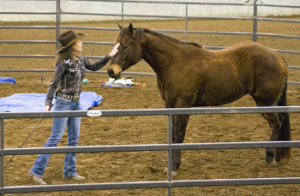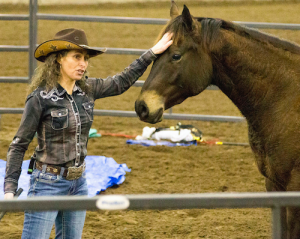Without a doubt, my favorite thing to teach people is how to understand what their horse is experiencing.
Love. It.
Why?
Understanding is the foundation for communication.
When it comes to understanding horses, the place to start is by teaching people to read the horses body language.
Horses are always communicating with us…but we need to use our EYES to listen.
Check out these three photos from my recent trip to Texas A&M. The photographer did a series of photos that captured the horse physically showing signs of a mental transition. Check it out:
In the first photo you can see the horse is standing still but he is visibly leaning backward. Look at his front legs. His ears are laser focused on me. Even in these less-than-high-res photos you can see that his eyes are very focused.
I am visibly moving toward him and he is physically and mentally processing it. His eyes, ears and front legs reflect the question, “What is she asking? Should I move now? Is she asking me to move again?” While his hind end reflects that he is somewhat relaxed because his left hind leg is resting, he is mentally experiencing some conflict.

Photo #1
In photo number two you can see that I have touched him. Look at the difference in his ears and eyes. When I touched him it helped him answer some of his questions. He doesn’t expect to be asked to move while I am rubbing his head, so the question ‘should I move’ has been answered. There is slightly less lean in his front legs but he hasn’t changed his legs much because they were partly relaxed to begin with.

Photo #2
This third and final photo does an excellent job of capturing a more detailed look at his facial expressions. I have continued to rub and he has continued to relax. His eyes and ears convey his thoughts. He speaks with his body language.

Photo #3
Two of my favorite places to watch are the wrinkles around their eyes and their nostrils. This is obviously less necessary if the horse is SCREAMING at you with other body parts (pinned ears, etc.) but as things become more subtle and detail oriented they are my go-to spots to watch.
Action plan: When you visit your horse today do five minutes of groundwork that you haven’t done for awhile. This could be sending them to a specific corner in the stall while you stand in the doorway, sending them over a tarp or asking them to back 10 feet while you stand in the same spot. Focus on their body language and decide what they are thinking.
13 Comments
Leave a Comment

FREE PDF DOWNLOAD
WHY IS MY HORSE...?
100% Private - 0% Spam
No one taught you the skills you need to work through these things.
Riders often encounter self-doubt, fear, anxiety, frustration, and other challenging emotions at the barn. The emotions coursing through your body can add clarity, or can make your cues indistinguishable for your horse.
Learning these skills and begin communicating clearly with your horse.
Click here to learn more.

Stacy, I am getting my degree in agriculture with an emphasis on equine science. A research paper I am writing right now for my final is about how you train and the advice you have for fellow trainers. I have quoted many of your articles and I appreciate you putting in the time to share your stories and knowledge with everybody. I look forward to reading more! Thank you for all you do.
I just found you and I’m already in love with how you train. You can tell that you care very much about the animal, which, in my opinion, is rare. I’ve been riding and training horses for about 20 years and I’ve learned a great deal of what I didn’t know in 30 minutes of reading this blog. Thank you. I will continue to tune in.
Hi Stacy,
I’ve been reading your books and following on FB for 3+ years. I had a horse accident then decided I need to learn more. I started with your book. I have read it twice. I LOVED the Jac series. I tell you, I don’t fully under the why, but I have been learning ground work and playing with my horse and my horse and I are better and better together. He is very steady and confident at home but is less confident on the trail or just away from home. I’m pleased to say after 3 years he goes away from home very confidently today. I have followed the Parelli program also, and have commented that there is such a strong similarities. Natural Horsemanship I figure.
None less, I’ll always be thankful for your books and writings as it sent me in the right direction and 3 years later I have a rewarding and full relationship with my horse. Thanks for the inspiration and information!
Jackie,
Thanks for the awesome feedback! Yes, the first bridleless ride I did caused people to ask me if I rode with Parelli…and I didn’t know who he was! When I eventually met Pat he said something like, we took different paths but ended up at the same end.
I’m so glad that I helped you find your path AND that you took the time to do the work! Congratulations!
Hi Stacy.
This is amazing! I learned so much just in reading this article. Te horse I ride sometimes doesn’t want to come in the barn and acts like she is spooked. I would love to understand if shes playing around or really spooked.I am also hoping to teach the horse I ride to let me ride her with just a neck rope. I would love some starter tips? I assume that this is the base (ground work) on which I would start teaching her. She sometimes likes to run right through the bridle when she has lots of energy (when I ride her) and doesn’t always listen very good. I would love to be able to have a connection with her so strong that I can ride with just a neck rope. I think it would improve our relationship and communication and make all of our rides easier. Thanks so much! Your are such a role model for me!!
Great thoughts – I have 10 horses with world class bloodlines from King and Waggoner Ranch and also some breeding from a Carol Rose Stallion. I go to Road To The Horse – have training cds from Clinton Anderson, Pat Parelli, Richard Winters. Love my horses – i like your comments – will do some of that this afternoon Thank You
Very interesting!
Love your advice. More please!
This was very interesting. Thanks!
I have a mare who was in training and got hurt so they had the vet hang a jug on her. No her vet that she has had since she was a baby we have to wrestle with her just to get shots. Anything I can do to help her?
Take a look at it from your mares point of view. At what point does she begin to change or get nervous when your vet is out? When the vet walks in the stall, when the vet preps the area before the shot, etc. Write down every step even if it seems silly, for example write: I open the stall door and two of us walk in together. Now go recreate as many of these steps as possible without your vet their. If your vet wipes down the injections spot, do it in this practice, if she pinches the skin or taps or has you hold the head a certain way…recreate it. Often, not always, but very often it is possible to trigger some level of what happens when the vet is there.
#2- Do more preparation before the vet arrives.
You know when your vet is scheduled to come give yearly vaccinations. Now it a great time to make a plan leading up to it. Horses that have been handled and worked regularly tend to behave better. They general exception to this are the horses that are good all the time. If your horse is less than perfect for shots the first thing I recommend is three days of hard work before the day that the vet is scheduled for shots.
How do I define hard work? Use the horse respiration rate. You can choose groundwork, riding or a combination of the two but your goal should be to raise the horses breathing rate significantly. This could mean 10-15 minutes of lunging followed by a five minute recovery walk while his breathing rate recovers. If he recovers in two minutes, work him harder the second day.
I’ve been guilty of this one before and I have noticed a difference in my horses. Thankfully my horses were still well trained enough to behave but the time off before hand did lower their normally perfect behavior slightly.
Give both of theses a try and let me know how it goes. I shouldn’t hear from you for at least a week because you need to put these actions into practice consistently before you will see sustainable changes.
Stacy, my daughter and I loved meeting you at A&M! I was the timid rider who asked you about teaching material at the end of the meet & greet. You mentioned a series you did on fear that hadn’t been edited. Whenever you post that it will be great. In the meantime, I’m learning a ton from watching your lessons with Jac. Thank you for teaching!
Yes! I remember! Thanks for the reminder on the FEAR video…enjoy the Jac series!